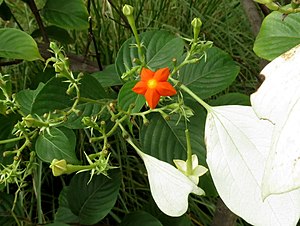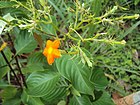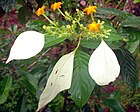Note: This is a project under development. The articles on this wiki are just being initiated and broadly incomplete. You can Help creating new pages.
Mussaenda frondosa
Mussaenda frondosa, the wild mussaenda or dhobi tree, is a plant of family Rubiaceae. It is a shrub that grows to about 1.5–2 m (4 ft 11 in–6 ft 7 in) tall. Like all other Mussaenda species, they have a large prominent white petaloid sepal in their flowers.
Contents
- 1 Uses
- 2 Parts Used
- 3 Chemical Composition
- 4 Common names
- 5 Properties
- 6 Habit
- 7 Identification
- 8 List of Ayurvedic medicine in which the herb is used
- 9 Where to get the saplings
- 10 Mode of Propagation
- 11 How to plant/cultivate
- 12 Commonly seen growing in areas
- 13 Photo Gallery
- 14 References
- 15 External Links
Uses
jaundice, ulcers, leprosy, asthma, hyperacidity, fever, cough.
Parts Used
Chemical Composition
Iridoids, flavonoids and triterpenes are the common chemical ingredients distributed in Mussaenda species. The most recognized compounds in Mussaendas are the iridoids and triterpene saponins. [1]
Common names
| Language | Common name |
|---|---|
| Kannada | ಬೆಲ್ಲೊಟ್ಟಿ bellotti |
| Hindi | बेदिना bedina |
| Malayalam | വെള്ളില vellila |
| Tamil | வெள்ளிமடந்தை velli-matantai |
| Telugu | |
| Marathi | NA |
| Gujarathi | NA |
| Punjabi | NA |
| Kashmiri | NA |
| Sanskrit | श्रीवाटी shrivati |
| English | Dhobi Tree, flag bush, white flag, white lady, white rag plant, wild mussaenda |
Properties
Reference: Dravya - Substance, Rasa - Taste, Guna - Qualities, Veerya - Potency, Vipaka - Post-digesion effect, Karma - Pharmacological activity, Prabhava - Therepeutics.
Dravya
Rasa
Guna
Veerya
Vipaka
Karma
Prabhava
Habit
Identification
Leaf
| Kind | Shape | Feature |
|---|---|---|
| Simple | elliptic leaves | 7.5-13.7 long, 4.5-8 cm broad, tip shortly tapering. Base is rounded or tapering into the 2-2.5 cm long stalk. Stipules are twin, lanceshaped. |
Flower
| Type | Size | Color and composition | Stamen | More information |
|---|---|---|---|---|
| Bisexual | flat-topped clusters | creamy-yellow elliptic, golden yellow | Actual flowers are 3-4 cm long, tube slender, very hairy. Berries are obovoid, 1-1.3 cm long. Flowering: April-November. |
Other features
List of Ayurvedic medicine in which the herb is used
Where to get the saplings
Mode of Propagation
How to plant/cultivate
A plant of subtropical to tropical areas, it is found at elevations up to 1,200 metres in Nepal. Prefers a sunny position. Prefers a soil with a pH around 7. [3]
Commonly seen growing in areas
Photo Gallery
References
External Links
- Ayurvedic Herbs known to be helpful to treat jaundice
- Ayurvedic Herbs known to be helpful to treat ulcers
- Ayurvedic Herbs known to be helpful to treat leprosy
- Ayurvedic Herbs known to be helpful to treat asthma
- Ayurvedic Herbs known to be helpful to treat hyperacidity
- Ayurvedic Herbs known to be helpful to treat fever
- Ayurvedic Herbs known to be helpful to treat cough
- Herbs with Flower used in medicine
- Herbs with Leaves used in medicine
- Herbs with common name in Kannada
- Herbs with common name in Hindi
- Herbs with common name in Malayalam
- Herbs with common name in Tamil
- Herbs with common name in Sanskrit
- Herbs with common name in English
- Habit - Herbs
- Index of Plants which can be propagated by Seeds
- Herbs that are commonly seen in the region of Garden area
- Herbs
- Rubiaceae





